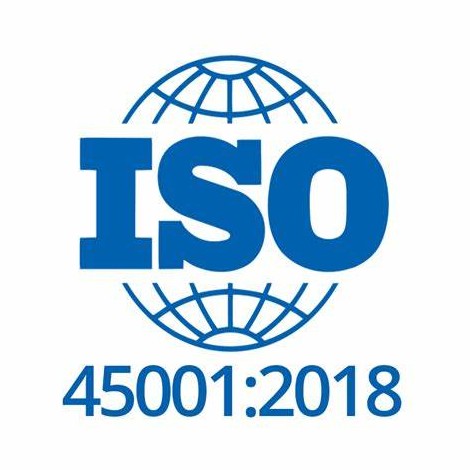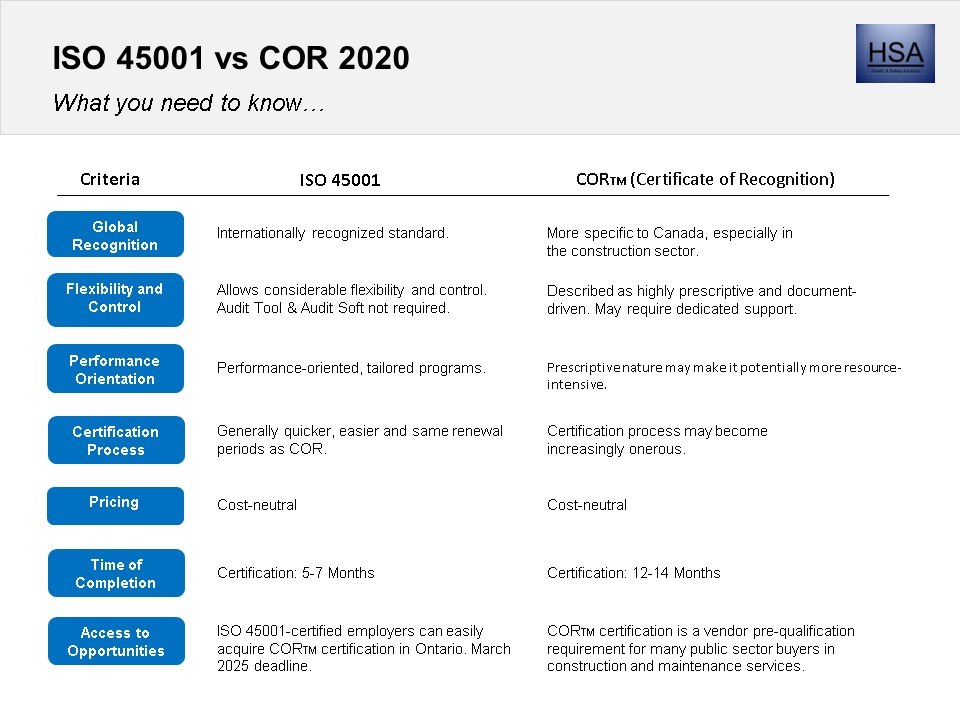
ISO 45001 Consultant Toronto
ISO 45001 is designed for organizations of all sizes, sectors and locations. ISO45001 is the world’s standard for safety and is recognized by 70 countries around the world. In Canada it is accredited by the Ontario Ministry of Labour, Immigration, Training and Skills Development.
Our HSA team of consultants will write and develop your ISO45001 program, provide you with an in-depth orientation and get you certified in as little as 3 months.
COR 2020 – Since COR was introduced in Ontario, IHSA has been providing equivalency certificates to organizations certified with ISO 45001. The IHSA now exclusively provide COR 2020 equivalency to organizations certified to ISO 45001. What does that mean? It means that your company can get a COR 2020 in approximately 30 days after completing your ISO 45001. You can get two Certificates for the price of one.
Contact us for your no obligation fee proposal for both a COR 2020 & an ISO:45001 Certificate.
See the IHSA link. https://www.ihsa.ca/COR/COR-Documents/ihsa-guideline-iso-45001-cor-2020-equivalency.aspx
FAQ
ISO 45001 is an international standard that outlines the requirements for an occupational health and safety (OH&S) management system. It is designed to help organizations create safer workplaces, reduce workplace risks, and improve overall health and safety.
ISO 45001 was created to provide a single, clear framework for organizations to improve worker safety and reduce workplace risks globally. It replaces OHSAS 18001 and aligns with other ISO management system standards like ISO 9001 (Quality Management) and ISO 14001 (Environmental Management).
Any organization, regardless of its size, industry, or location, can implement ISO 45001. It is especially beneficial for organizations that want to formalize their commitment to worker safety and health, reduce risks, and comply with legal and regulatory requirements.
Certification to ISO 45001 is voluntary. However, some industries and clients may require certification as proof of an organization’s commitment to workplace health and safety.
Benefits of ISO 45001
Key benefits include:
- Improved employee safety and morale
- Reduced workplace accidents and injuries
- Enhanced compliance with legal and regulatory requirements
- Reduced costs related to workplace incidents
- Better reputation with clients and stakeholders
ISO 45001 provides a structured approach to identifying and mitigating workplace hazards, improving overall worker safety and well-being. It encourages worker participation in safety initiatives, promoting a culture of health and safety.
Transitioning from OHSAS 18001 to ISO 45001
Organizations should conduct a gap analysis to identify differences between their existing OHSAS 18001 system and ISO 45001 requirements. After addressing these gaps, organizations must update their documentation, train employees, and undergo a certification audit for ISO 45001.
The official deadline to transition was set for March 2021. Any organization still using OHSAS 18001 should transition to ISO 45001 to remain compliant and demonstrate adherence to the latest OH&S standards.
Key Requirements and Clauses
ISO 45001 is structured around several clauses, including:
- Clause 4- Context of the Organization
- Clause 5- Leadership and Worker Participation
- Clause 6- Planning
- Clause 7- Support
- Clause 8- Operation
- Clause 9- Performance Evaluation
- Clause 10- Improvement
The PDCA cycle is a continuous improvement process that ISO 45001 follows:
- Plan – Identify and assess risks and opportunities, set objectives.
- Do – Implement OH&S processes to manage risks.
- Check – Monitor and evaluate the performance of OH&S processes.
- Act – Take corrective actions and make improvements.
Implementation and Certification
Implementing ISO 45001 involves several key steps:
- Hire a competent Consultant (HSA)
- Conduct a gap analysis.
- Develop an implementation plan.
- Train employees on the standard’s requirements.
- Implement procedures and documentation to address OH&S risks.
- Conduct internal audits and review by management.
- Apply for certification from an accredited body.
The timeline for certification depends on the organization’s size, complexity, and existing safety practices. Small organizations may achieve certification in 3-6 months, while larger organizations may require a year or more.
Organizations can implement ISO 45001 on their own if they have sufficient expertise in OH&S management. However, many organizations find it beneficial to hire a consultant for guidance, especially if they are new to ISO standards.
ISO 45001 helps organizations identify and comply with legal and regulatory requirements related to health and safety. While it doesn’t guarantee compliance, it provides a structured approach to maintaining and monitoring compliance.
ISO 45001 requires organizations to identify, assess, and mitigate risks to health and safety. It emphasizes proactive risk management by encouraging hazard elimination and the implementation of protective measures.
ISO 45001 emphasizes worker participation in the OH&S management system. Employees are encouraged to participate in hazard identification, risk assessment, and decision-making processes related to safety.
ISO 45001 includes worker health and well-being within the scope of OH&S management. While it primarily focuses on physical safety, it also encourages addressing mental health factors that may impact overall worker well-being.
Organizations should regularly monitor and review their ISO 45001 system. Internal audits and management reviews should be conducted at least annually, and organizations must remain committed to continual improvement.
ISO 45001 certification is typically valid for three years. Organizations must undergo surveillance audits annually to maintain certification, with a recertification audit required at the end of the three-year period.



